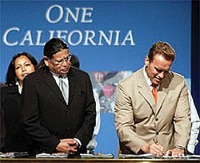
Since its 1988 passage, the Indian Gaming Regulatory Act (IGRA) has provided a statutory vehicle to promote economic development for federally recognized Indian tribes throughout the United States. The goal of the act was to encourage self-sufficiency and strong tribal governments via the operation of casino gaming on their reservation lands.
Sheila Morago, executive director of the Arizona Indian Gaming Association (AIGA), praises the IGRA as the most successful economic legislation ever created for Indian tribes.
“Prior economic tools worked for metropolitan areas with built-in infrastructures. They never addressed those rural tribes that needed funding to create solid infrastructures. Gaming offered a positive alternative,” she says.
The IGRA followed the U.S. Supreme Court’s 1987 ruling on California v. Cabazon Band of Mission Indians. The decision allowed California tribes to conduct high-stakes bingo on reservation lands, free of state regulation.
Heidi McNeil Staudenmaier, senior partner at Snell & Wilmer LLP, a law firm in Phoenix, Arizona, explains, “Tribes have always believed in their inherent right to operate gaming activities on their reservation lands. As a compromise, the IGRA provided a regulatory structure for Class II and Class III gaming. From a tribal perspective, they were agreeing to let the state and federal governments participate.”
The language of the IGRA emphasizes three important areas. It provides for Indian gaming regulation, designed to prevent organized crime and corruption, while ensuring that tribes are the primary beneficiaries of gaming revenues. The IGRA aims to ensure integrity in Indian gaming operations for the operators and players.
Class Promotions
The IGRA divides all gaming activities into Class I, II and III operations. States cannot regulate Class I, or traditional Indian games (and no tribe currently offers Class I games to anyone but tribal members). Class II low-stakes games, like bingo, can be regulated the same way as other similar activities within a state. For Class III high-stakes Las Vegas-style gaming operations, the IGRA authorizes regulatory mechanisms with individual states, via a negotiated compact. Compacts are then approved or rejected by the Deparment of the Interior (DOI).
In some early cases, states quickly agreed to compacts, thinking it would never amount to anything significant. Others refused to negotiate and faced legal challenges.
The IGRA bars a state compact from taxing tribal casinos, but allows revenue-sharing agreements. Staudenmaier states that each state has taken a different approach to negotiating compacts. Some compacts have few rules and little involvement, while others mandate extensive regulatory oversight and operational limitations.
Due to the overwhelming successes of Indian gaming, the tribal and political landscape has changed since 1988. Recognizing that they underestimated the returns from Indian gaming, some states have scrambled to renegotiate better compact terms.
Other components of the IGRA were the formation of the National Indian Gaming Commission (NIGC), an independent federal regulatory authority. Its purpose was to oversee the management and regulation of Indian gaming. Finally, the law also established standards for tribal land acquisitions and off-reservation gaming operations.
Casino Compromise
Chairman Michael Lombardi of the Southern California Augustine Band of Cahuilla Indians Gaming Commission has worked in Indian gaming operations for decades.
“IGRA was a political compromise for the Cabazon v. California case,” he contends.
Lombardi applauds the early efforts of Senator Daniel Inouye (D-Hawaii) and former Senator Ben “Nighthorse” Campbell (R-Colorado).
“These two individuals were the best friends of Indian gaming. They believed the IGRA would force state and tribal governments to develop respectful government to government relationships,” he claims.
The IGRA’s expectation of enhancing Indian gaming’s economic growth has surpassed all projections. A once fledgling revenue source has evolved into a massive entertainment and leisure industry.
According to recent data from the National Indian Gaming Association (NIGA), Native American gaming employed 670,000 jobs nationwide for American Indians and its neighboring communities. Tribal casinos generated approximately $25.7 billion in gross gaming revenues in 2006, plus an additional $3.2 billion in related hospitality and entertainment services gross revenues. Indian gaming has paid billions in federal, state and local taxes and $100 million to charitable organizations.
By 2008, the Indian gaming industry has grown to total more than 200 tribes who operate more than 400 casino properties in 26 states. Not every venue is a success, but most do well enough to provide employment and improve the education and standard of living for most tribal members.
“The superstar casinos are on both coasts,” explains Morago, “with a few in between. Most of the small, rural venues are doing all right. The casinos provide employment and mitigate the shrinking federal dollars coming their way. Also, the young people know they can expect to get jobs.”
Legal Challenges
In 20 years, both NIGA and the NIGC have often operated at cross-purposes. Some NIGA member tribes have sometimes considered the NIGC’s position an infringement on tribal compacts and sovereignty.
NIGC Director of Congressional and Public Affairs Shawn Pensoneau says, “The job of monitoring tribal gaming is large enough that most states cannot do it. The NIGC totally supports the notion that tribes are the primary regulators. However, as the industry has grown, our oversight role remains important.”
The situation peaked when the Colorado River Indian Tribe (CRIT) of Arizona sued the NIGC. In 2006, the U.S. Court of Appeals in Washington, D.C. marginalized the NIGC’s statutory authority. It barred the NIGC from issuing minimum internal control standards (MICS), initiated in 1999, for Class III tribal casinos that operate under state compacts.
The ruling affirmed a 2005 summary judgment of the District Court for Washington. The decision immediately suspended numerous federal audits and authorized tribal refusals to allow NIGC investigators into their gaming operations.
NIGC Chairman Philip Hogen quickly petitioned the Senate Indian Affairs Committee in November 2006, claiming that if the ruling were upheld, federal law enforcement would be “crippled in its efforts to protect the integrity of tribal gaming operations.” The FBI, and numerous federal prosecutors who have participated in investigating dozens of cases of alleged criminal activity relating to Indian gaming operations, have supported the NIGC’s dissension.
The CRIT decision has also sounded alarms for some lawmakers. In March 2007, Senator Dianne Feinstein (D-California) contacted Senator Byron Dorgan (D-North Dakota), chairman of the Senate Committee on Indian Affairs, and ranking member, the late Senator Craig Thomas (R-Wyoming). Her letter relayed her deep concern for the integrity of tribal gaming in California if the CRIT decision diminished the NIGC’s authority.
Other legislation to create new barriers to off-reservation Indian casinos has been proposed and defeated, including a bill from former Congressman Richard Pombo (R- California) in September 2006. It attempted to limit what some term “reservation shopping.” However, while defeated, new land policies have since emerged.
Amend It Or Leave It Alone?
The meteoric growth of Indian gaming has also fueled efforts in the past several years to amend the IGRA. Thus far, congressional efforts have failed, due in part to the diligence of groups like NIGA and the National Congress of American Indians, America’s oldest Indian organization. The two have formed an alliance to effectively lobby the Congress in Washington D.C.
Presidential candidate Senator John McCain (R-Arizona) introduced legislation-S. 2078- in 2005, when he served as chairman of the Committee on Indian Affairs. Despite seeking changes, Staudenmaier says that over time, McCain has tried to maintain a fair, even-handed approach to Indian gaming.
“Most tribes would agree that Senator McCain has been a friend of Indian gaming,” she says.
McCain ended his chairmanship in December 2006, charging that the 109th Congress had failed to pass what he considered vital reforms. Despite numerous hearings in his committee, McCain and his members dissented as to whether the proposed changes were too restrictive or too lenient.
Some constituent groups wanted it left alone, fearing that close examination would open up the proverbial “can of worms” and negatively affect their tribes. In the Congressional Record on December 8, 2006, McCain lamented, “It seems that these people assumed that ignoring the problems is a better policy than confronting them.”
McCain’s two major concerns were the erosion of the NIGC’s oversight role, thanks to the CRIT ruling, and the lack of specifics relating to casinos located far from a tribe’s reservation land. He implored the upcoming 110th Congress to address what he labeled as critical issues for the future successes of Indian gaming.
Morago says that AIGA advocates “working the legislation as long as possible” to make any changes as palatable as possible. She says, “Arizona has 22 tribes. Twenty-one tribes have signed gaming compacts and 15 have gaming agreements. AIGA has 19 member tribes. Via machine transfer agreements between individual tribes, there are 22 total gaming operations in Arizona. We realize it is important for tribes to work with the legislation when possible. We can always say ‘no’ at the end of the process.”
Where To Allow Indian Gaming To Operate
Historically, the federal government has owned all Indian reservation land in the continental United States. Laws from the 1800s allowed the Secretary of the Interior (SOI) to take Indian lands into trust.
“Still on the books, the law attempted to ‘protect’ tribes from selling to what the government considered unscrupulous individuals. The paternalistic law is archaic and condescending to tribal authority,” Staudenmaier says.
The IGRA bars tribes from conducting gaming on land unrecognized as reservation lands or designated “Indian lands” prior to October 17, 1988. The language does include exceptions for tribes without land, those who settle land disputes and those who lost land, but regained their federal recognition status.
Land not conforming to those standards must obtain the approval of both the individual governor and the SOI through a two-part determination. The analysis explores whether the land acquisition is in the tribe’s best interest and will be favorable to the surrounding community. Only three tribes have received this approval since 1988.
Some view this as “reservation shopping.” The DOI addressed the issue definitively in January 2008 by rejecting 22 applications for new off-reservation casinos. The DOI used a single criterion-the distance from the reservation- as the foundation for the decision. Ten applications were for land from 160 to 1,550 miles away from a tribe’s reservation. Several crossed into another state.
Following a McCain proposal that would have eliminated the two-part decision process for any tribes applying after April 15, 2006, a flood of applications poured in to the DOI. Intense lobbying by the tribes defeated that bill, but the applications remained on file
The new DOI guidelines may require that any new lands be within a commutable distance of 75 to 100 miles from a tribe’s historical land. Staudenmaier says, “Some view this new policy as a potential death knell for the future.”
Politics Makes All The Difference
While strength in numbers is good, strength in political numbers makes all the difference. Since the passage of the IGRA, Native Americans have come to enjoy a newfound political power. Morago says, “When the voting margin is a few percent, we are delighted that tribes may make that ballot difference.”
Democrats have enjoyed an especially close bond with the tribes. Industry analysts state that the Democratic Party and its candidates have advocated more for tribal sovereignty and interests than the Republican Party. However, Lombardi says that may change. “Due to his history with tribes, Senator McCain will force Democrats to compete this year,” he says.
In 2006, the Center for Responsible Politics reported that Democrats have fared better by two-to-one from tribal political contributions. The Washington, D.C. non-partisan, non-profit research group tracks political financing and analyzes its effect on elections and public policy.
It may be the most apparent in California. The University of California’s Institute of Governmental Studies Library reported that California Indian tribes have become the largest contributor to California political campaigns.
For Lombardi, the influence of Indian Country is the realization of decades of hard work and hope. He says, “One success of Indian gaming is the formation of political coalitions that have grown into a powerful voting bloc.” He claims that California Governor Arnold Schwarzenegger has realized the impact of tribal gaming throughout California since the initial compacts were ratified by Proposition 1A in March 2000.
In California, Indian gaming has generated billions, totaling $7.7 billion in 2006. Gaming has become so lucrative that hundreds of Native Americans are petitioning the Bureau of Indian Affairs for recognition of new California tribes in order to build casinos.
Schwarzenegger has altered his position on Indian gaming since his early days in office, and embraced its positive impact.
“Unfortunately, Indian gaming has become a piggy bank to some, but Governor Schwarzenegger recognized the advantages of positively working with the tribes,” Lombardi says.
California’s February 2008 Proposition 94, 95, 96 and 97 ballot questions proved his recognition of Indian Country’s viability, both politically and economically. The language is virtually identical, but each deals with specific groups-the Pechangas, the Morongo, the Sycuan and Agua Caliente tribes.
The legislation, which passed, allows for more machines, self-auditing, internal environmental analysis and a “fail safe” guarantee to reduce or eliminate tribal taxes if California opens other casinos.
What Lies Ahead?
Despite the introduction of S. 2676, called the Common Sense Indian Gambling Reform Act of 2008, by Senator David Vitter (R-Louisiana) in February 2008, it is unlikely for anyone to press for legislation, which fundamentally impacts the IGRA, in an important election year. As of press time, there are no co-sponsors, and experts agree that it could create way too much of a political backlash.
What Vitter wants is to again attempt to amend the IGRA, specifically addressing the land-in-trust and two-step determination issues, NIGC authority and fees and defining the “State” as both a governor and the state legislature.
Looking into the future, it may be difficult to uniformly amend the IGRA. The states and their perspectives are often very diverse since tribes have diverse needs in given situations.
While certain changes may be inevitable, based on the explosion of Indian gaming, Staudenmaier believes most tribes desire the status quo. She says, “The majority of tribes can live with what is there. The IGRA may be far from perfect, but they feel the best course is to keep it because to open it to changes can lead to more negative than positive.”
Morago states, “Various factors will affect what happens. As budgets and the economic situations change, tribes may face increased competition from states that will introduce new gaming as an alternative economic vehicle. It may force tribes to renegotiate their own state compacts.”


















